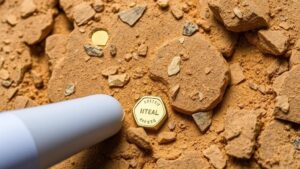Exploring Ancient River Channels for Hidden Gold Deposits
Exploring Ancient River Channels for Hidden Gold Deposits
The pursuit of gold has captivated humanity for centuries, with historical evidence showing that ancient civilizations often settled near rivers, drawn by the promise of precious metals. This article delves into the techniques used to explore ancient river channels for hidden gold deposits, highlighting their geological significance, archaeological importance, and practical applications in modern prospecting.
The Geological Formation of Gold Deposits
Gold deposits are typically associated with the processes of weathering and erosion, which occur within river systems. Ancient river channels, known as paleochannels, represent past hydrological landscapes where gold can concentrate due to several geological mechanisms.
- Alluvial Deposits: As rivers erode the surrounding landscapes, they transport various sediments, including gold particles. Once the rivers flow decreases, gold settles in areas of lower energy, such as bends and eddies.
- Fluvial Sorting: The physical properties of gold, such as its high density, allow it to be effectively separated from lighter materials like sand and silt during sediment transport.
For example, in the Klondike region of Canada, gold was concentrated in ancient riverbeds, leading to significant discoveries during the Gold Rush era. The Klondike Gold Fields were actually ancient river systems now buried under layers of soil and rock.
Archaeological Significance of Ancient River Channels
Studying ancient river channels offers insights not only into geological processes but also into human activity and societal development. Rivers have historically been vital for trade, agriculture, and sustenance. Proximity to water sources often influenced the locations of ancient settlements.
- Trade Routes: Ancient civilizations, such as the Egyptians and Mesopotamians, utilized rivers for commerce, and the discovery of gold artifacts in these regions indicates the historical significance of these waterways.
- Cultural Artifacts: Excavations around ancient river channels have revealed a plethora of artifacts, including tools and jewelry, which help establish the socio-economic conditions of early societies.
A notable example is the detection of gold jewelry along the banks of the Indus River in Pakistan, suggesting a thriving civilization that engaged in trade and craftsmanship related to gold.
Modern Techniques in Gold Prospecting
The quest for gold in ancient river channels has evolved significantly, employing modern technologies in mineral exploration. Geophysical methods and remote sensing are now fundamental in identifying potential gold deposits buried within ancient channels.
- Ground Penetrating Radar (GPR): This non-invasive technique allows geologists to visualize subsurface anomalies, helping to locate ancient riverbeds without extensive excavation.
- Geochemical Analysis: Soil samples can be analyzed for trace elements associated with gold, enabling focused exploration efforts in promising areas.
An implementation of these techniques can be seen in Californias Sierra Nevada range, where modern prospectors utilize GPR to identify likely areas for gold recovery while minimizing environmental disruption.
Challenges and Ethical Considerations
Exploring ancient river channels poses certain challenges and raises ethical concerns. Environmental impacts must be weighed against the potential for gold recovery, particularly in regions that are ecologically sensitive or culturally significant.
- Environmental Degradation: Gold prospecting can lead to habitat destruction and water quality issues due to dredging and other intrusive methods.
- Cultural Heritage: Many ancient river channels are adjacent to archaeological sites, making it crucial to balance exploration with preservation efforts.
In areas like the Amazon rainforest, the conflict between artisanal mining and conservation efforts illustrates the ongoing struggle to balance economic gain with ecological and cultural preservation.
Actionable Takeaways
For those interested in exploring ancient river channels for hidden gold deposits, consider the following:
- Research past river systems and their geological characteristics to identify potential gold-trapping features.
- Use modern technologies, such as GPR and geochemical analysis, for effective and less invasive prospecting.
- Engage in ethical prospecting practices that ensure the protection of both the environment and cultural heritage.
To wrap up, uncovering hidden gold deposits within ancient river channels offers a fascinating intersection of geology, archaeology, and modern science. By leveraging both historical knowledge and contemporary techniques, prospectors can continue to discover the treasures of the past while respecting the complexities of todays world.



